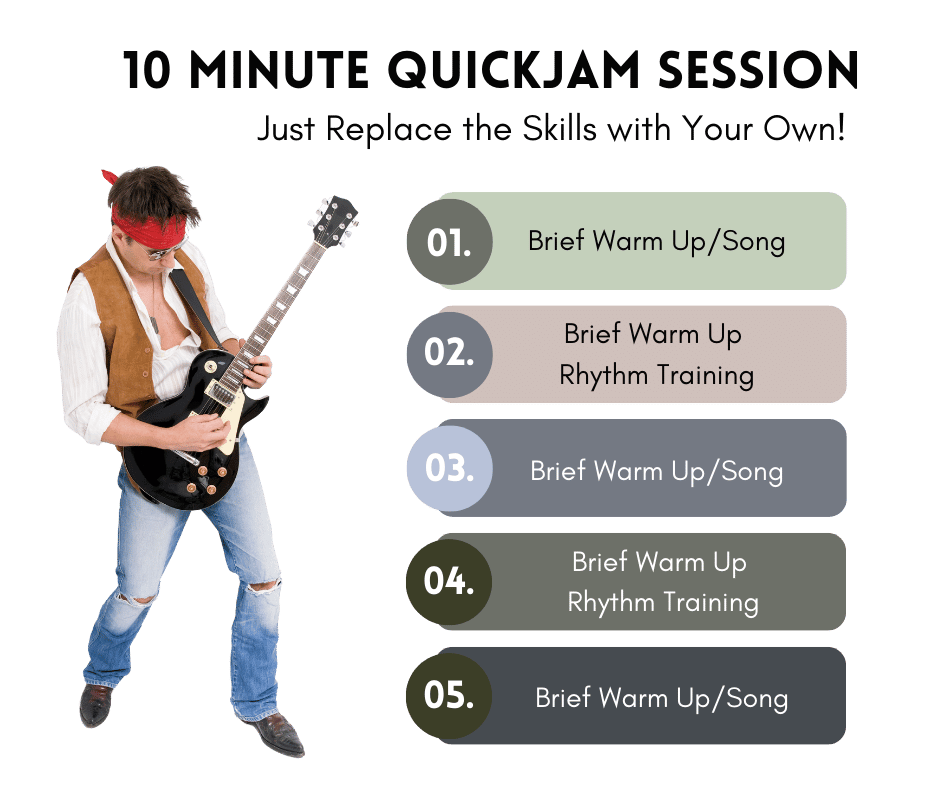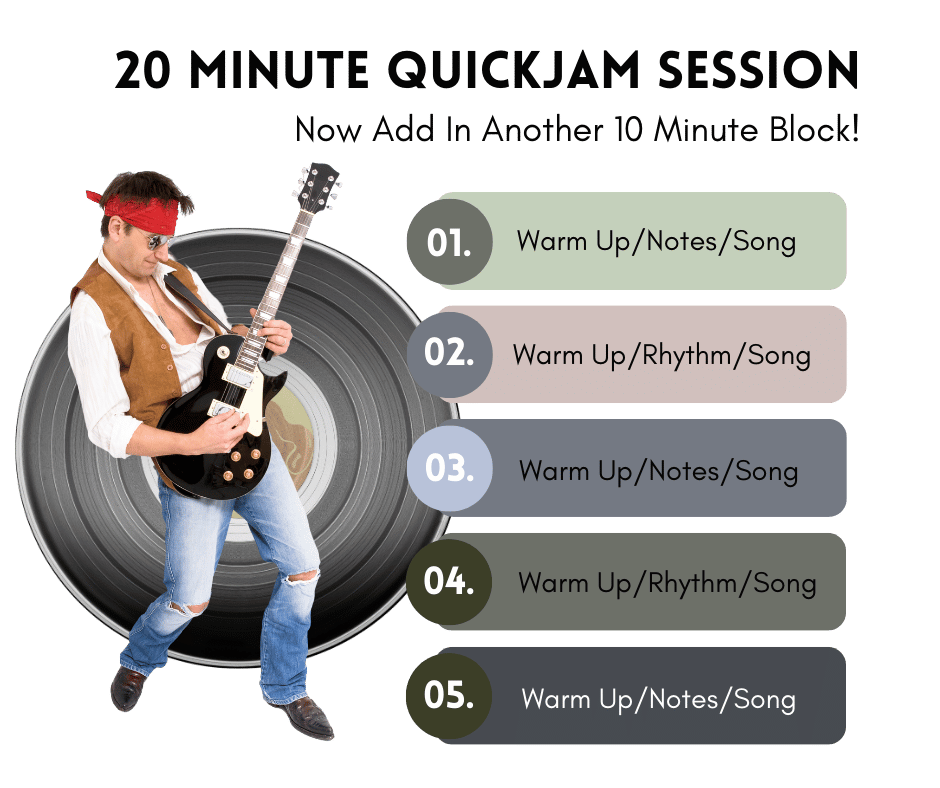THAT POWER OF 10- MINUTE PRACTICE SESSIONS
The Power of
10-Minute Practice Sessions!
Let's begin by exploring why 10 minutes is an ideal time frame to concentrate on a single subject. Whether you have just 10 minutes or an entire hour, this short yet effective period allows you to dive into one topic, gain some depth and stay engaged without feeling overwhelmed. It's a manageable chunk of time that helps you get into the zone and make meaningful progress, while also not being so long that your progress begins to diminish.
For instance, while practicing a song might naturally extend into a longer session, a focused 10-minute practice session is perfect for most other areas of study. The key is to maximize this time by staying on task and making every minute count. This way, you can make significant strides in your practice in a much shorter time. When you get into this habit then it will also continue on into your longer practice sessions. You build the habit and in the end your overall result dramatically improve, whether it's 10 minute sessions of 2 hour sessions!
Identify Your Primary Focus: Start by determining the main element of your practice session. This could be mastering a song, working on riffs to improve your rhythm skills, practicing a solo to enhance your lead techniques, or focusing on any other specific skill area you want to develop. Choose what aligns best with your current goals. For example, let's make a song our primary focus for this imaginary session.
Select a Secondary Focus: After establishing your main focus, it's beneficial to choose a secondary focus to complement your practice. This secondary focus should support or enhance your primary goal. For example, if your main focus is mastering a song, you might select rhythmic training as your secondary focus, to help improve your timing and rhythm techniques.
With your main focus on the song and your secondary focus on rhythmic riffs, you can now structure your practice session.
Note:This part is extremely important! For a 10-minute practice routine to be effective, you need to follow the directions exactly. The only thing you should adjust is the actual area of focus, as these will be unique to you.
__________________________________________
Structuring Your Practice Week
You'll be practicing for 10 minutes each day, five days a week. If you have extra time, feel free to extend your practice session, but for now, we'll focus on maximizing those 10 minutes.
Focus on your main area, such as the song in our example, on days 1, 3, and 5. Start each session with a brief warm-up, then dive into your primary focus. On days 2 and 4, shift your attention to your secondary focus area. In our example this would be Rhythmic Training.
Maintain this practice routine, incorporating any additional time whenever possible, until practicing 5 days a week becomes a regular habit. Once you are consistently practicing for around 10 minutes each day and feel ready to expand on things, consider adding another 10-minute block to work on additional areas.
__________________________________________
20 Minute QuickJam Sessions
You'll continue with your usual routine, but now add another 10-minute block, making it 20 minutes in total. This additional time can be used to focus on another skill, another song, or any other area you wish to improve.
For our example, let’s say we want to learn the names of the notes on the neck, so we'll also focus on note memorization. We now have three focus areas: songs, rhythmic work, and note memorization. Let’s explore how you could arrange this:
We kept our focus on the song every day while alternating rhythm training and note memorization (Notes) on odd and even days.
It's important to note that you don't need to complete a 20-minute block all at once. Since each block is divided into 10-minute segments, you can spread them out over the day. For example, you could practice for 10 minutes in the morning before work and then another 10 minutes in the evening before settling down and relaxing in front of the TV!
__________________________________________
Integrating New Skills
If you are progressing well and ready to add another skill area, such as a guitar solo for example, then go for it! Continue to practice your main focus area every practice day as usual. Then, we need to prioritize the remaining skills. Out of rhythmic work, note memorization, and the solo, let’s decide which will be the main focus and which will be secondary.
Let’s say that you really want to focus on rhythm since it’s the most important area of study for you. The second most important area might be the solo, and finally, you'll have note memorization as the third area. Your practice schedule might look like this:
In this example, we practiced the song each day, alternated between rhythm training and solo, and focused on note memorization along with the song on day 5.
__________________________________________
Customizing Your Routine
With more practice time available, you have more options to customize your sessions. One approach could be to practice the song all five days, rotating the remaining three skill areas on consecutive days.
Alternatively, you could focus on the song and skill areas on consecutive days while you use day five as a jam day. You could then go through your new song, run through past songs, maybe work on the solo, etc...
You can get creative with your practice schedule, but it’s crucial to ensure that your primary focus area is practiced in almost every practice session. Here are a couple sample schedules:
As you move into the following week, you'll continue rotating the skills. In this case, the next skill will be notes, followed by the solo. This means on day 1 of the next week, you'll practice the notes, on day 2 you'll practice the solo and so on, continuing in this pattern moving forward.
__________________________________________
Expanding Your Practice Sessions Further
If all goes well, you could add yet another 10-minute block, increasing your practice time from 20 minutes to 30 minutes, and then add another block to bring it to 40 minutes, and so on.
A couple of things to keep in mind: As you add extra 10-minute blocks, be cautious not to overload yourself with too many new subjects. Adding too many subjects can cause you to lose focus overall. Aim to have only 4-6 areas of focus in your routine.
That is, unless you practice for hours each day, which, if you are reading this, is probably not the case. It’s much better to expand on subjects you are already working on and need some extra practice with. Plus, as you learn more songs, you’ll likely be working on a couple at a time.
Staying Focused and Consistent
The key here is to always keep your eye on the ball. Whatever you do, don’t lose focus on your main practice area. And remember, if your practice routine begins to fall apart, don’t just give up! Go straight back to the 10-minute blocks again.
While, for example, a 30-minute routine offers more flexibility to customize and experiment with, the 10-minute routine requires strict adherence. Since this is such a small amount of time, it's crucial to follow the routine exactly as presented to achieve the best results. By all means, experiment if you have additional time available!
The secret sauce here is to stay committed to your practice and trust the process. Whether you're working with 10-minute blocks or longer sessions, the most important thing is to keep your focus sharp and your dedication unwavering.
Remember, every minute you invest in practice brings you closer to your goals. If you hit a rough patch, don't get discouraged—return to the basics and rebuild your routine. Your persistence and passion will drive your progress. Keep pushing, keep playing and keep rockin’!
Don Parkhurst Jr. - RockStar Guitar Academy
Discover the RockStar Way!
Want to know more about our Rock Guitar Program? Book a studio meet-up or an online chat and I'll give you the full scoop.
Sign up for your Backstage Pass today and lets talk about how I can help you achieve your goals and dreams!
Need More Assistance?
Fill Out the Form Below to Connect with Us
We're here to help with any general questions or feedback. For detailed program inquiries, please sign up for our Backstage Pass
rockstar guitar Academy
© Copyright 2024 RockStar Guitar Academy. All Rights Reserved




